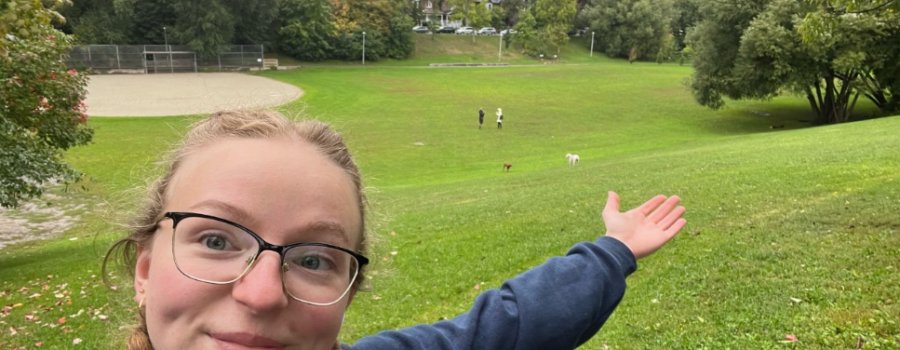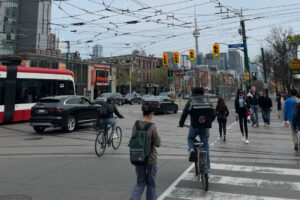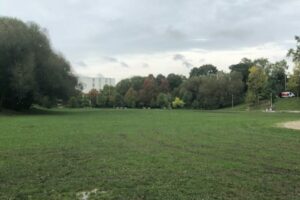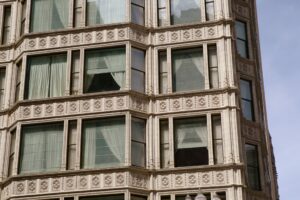Long before Toronto looked anything like it does today, numerous waterways carved their way through the land. One such waterway was Garrison Creek, which resulted from two streams joining and flowing as one out to the lake (Bateman, 2012). The creek left a valley behind and it is in this valley that Bickford Park resides, between today’s boundaries of Harbord Street and Bloor Street in the Palmerston-Little Italy neighbourhood. The park is named after Edward Bickford, who sold the land to the city in 1908 (“History,” n.d.). In the century since then, Bickford Park has seen a series of changes that led to its current collection of natural and artificial amenities. These encourage health and interaction in the community which causes members to invest in the park and proves that green spaces are key aspects of urban centres.
Since Bickford Park is in a valley, it is surrounded by hills that block much of the sounds and sights of the city and create a serene environment within the park. This effect is furthered by trees that ring the perimeter. The hills are often used for picnics, dates, or just as a quiet place to sit and look out over the park. There is much to be seen since the field at the bottom of the valley hosts a variety of activities, many of which are for exercise: a football team running drills, friends tossing a frisbee back and forth, and joggers on the paths that cut through the field and wrap around the perimeter. These natural amenities are important to the community because visitors can choose how they engage with them. This increases the health benefits, which “stem both from the opportunity to engage in healthy outdoor exercise and from the psychological effects arising from … a less stressful, more relaxing environment” (Swanwick et al., 2003). People value their freedom of choice, so the decision to change their surroundings and their activities benefits them mentally while the exercise and fresh air benefit them physically. Spaces that provide these opportunities are vital to the success of an urban community.
Bickford Park is also home to several man-made amenities, most notably the baseball diamond and the dog park. The baseball diamond hosts local children’s teams for both practices and games throughout the summer, along with their audiences. Dog owners visit so that their pets can exercise and while most stay within the fenced area, there are some who choose to go out into the field and interact with others there (as seen in figure 1). The combination of natural and artificial amenities makes Bickford Park a place where a wide range of activities and interactions can happen within a relatively small area. This approach to urban parks was encouraged by Frederick Law Olmsted, the landscape architect and urban planner behind Central Park, who wrote that “if a given piece of public property can be used effectively for two or more purposes, it ought to be so used” (Olmsted, 1917). This is important in the context of urban studies because it acknowledges the limited amount of space within a city and the benefit of meeting as many of the community’s needs as possible within that limited space.
When Lewis Mumford examined the concept of the city, he concluded that “social facts are primary, and the physical organisation of a city … must be subservient to its social needs” (Mumford, 2011). Bickford Park is a testament to this ideal because its physical location is within an accessible range for its community so that their needs for health and interaction can be met. The park cannot support all of Toronto but in a polynucleated city, it only has to serve its small community within the wider urban scope. When a space can meet a community’s social needs, the community will value the space in return and invest in it. In Bickford Park’s case, there are volunteer cleanups twice a year and community members work with policy makers to keep the park in good condition and petition for its improvement (“About Us,” n.d.). Bickford Park is the backdrop for increasing connections between urban thinkers and urban residents—a concept that will improve the future of urban planning (Schafran, 2014).
For over a century, Bickford Park has been a key aspect of its community and it will continue to be in the future. Its combination of natural and artificial amenities encourage interaction and attract a variety of people groups, contributing to the health and vitality of each one. This has meant that the community values the park and seeks to improve it across a range of categories, including accessibility and weather dependency; the hills are too steep to be accessible for people with mobility issues, and the lack of covered spaces means that the park becomes practically deserted when the weather turns rainy or cold. The City of Toronto and its urban planners could address these issues if they acknowledged the importance of this thread of green space within its wider urban fabric and invested in it so that it could benefit a wider range of city dwellers.





